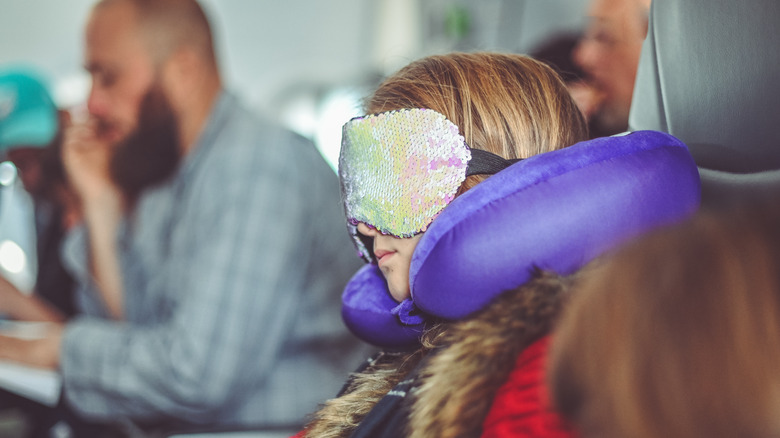There’s a reason overnight flights are often cheaper than flights at less horrendous times. They can be miserable, and lots of people avoid them at all costs. These “red-eye” flights earned the name thanks to the bleary, bloodshot eyes of sleep-deprived passengers on these overnight trips. Of all the indignities of travel, trying to get some sleep on an airplane is up there with the worst.
That doesn’t mean you should give up on the idea of catching forty winks while you fly, however. Despite what your caffeine-addled, college-aged self may have believed about all-nighters, some sleep is better than no sleep. Even spending some quiet, restful time (known in sleep circles as “quiet wakefulness”) has benefits. At the very least, a catnap in your seat can help pass the time.
But before you pull on the noise-canceling headphones and wash your sleeping pills down with brandy, beware. The internet is full of tips and tricks to help you sleep on a plane, but there can be downsides — or even dangers — that may not have occurred to you.
Why is it so hard to sleep on a plane?
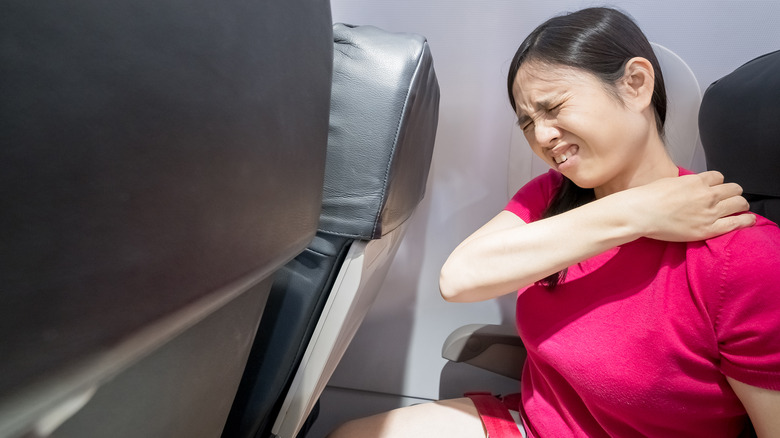
Before we dive into unpacking some sleep advice, let’s talk about some of the main reasons people struggle to get a restful sleep while in the air.
People’s main complaint is comfort. In economy class, the average seat is 17 inches wide, with between 30 and 32 inches of legroom (known as the pitch). A small study from The London Sleep Centre (review in Sleep Review) found that the participants who slept in 18-inch plane seats twitched and woke less and reported a more restful sleep than those who slept in a 17-inch seat.
It hardly feels necessary for a scientific study to tell you that the presence of a few hundred other passengers, the relative upright position of your seat, and periodic interruptions keep a person from having a restful sleep. On top of that, even transcontinental flights aren’t always long enough to allow you to fall into a sleep that is deep enough to be restorative.
Have a few drinks
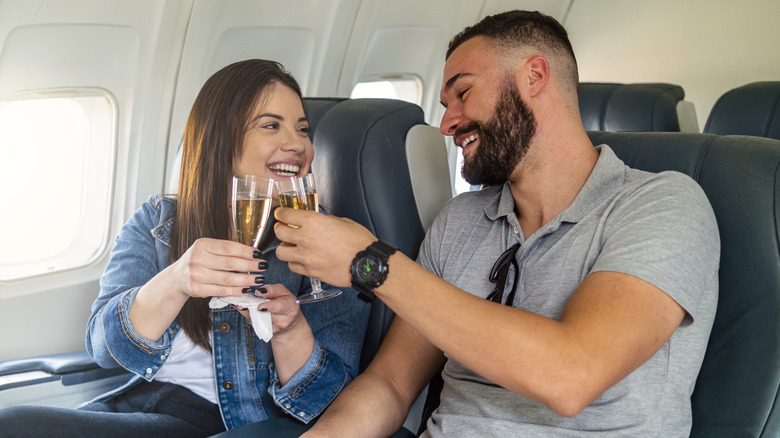
A nightcap on the plane may seem like a nice way to relax and send yourself off to dreamland, but overdoing it is a recipe for disaster. First of all, alcohol may help you fall asleep, but it won’t keep you sleeping, and the rest you do get is poor quality. Secondly, alcohol can dry you out. The National Institute on Alcohol Abuse and Alcoholism (NIAA) states that hangover symptoms like fatigue and headache are made worse by the dehydrating effects of booze. Pair that with the notoriously dry air in a plane cabin, and your few extra glasses of wine can make your landing less than happy.
Remember that booze tends to hit you quicker at high altitudes and can contribute to tipsy feelings, like lightheadedness or dizziness. Don’t be tempted to test your limits, even in the name of getting some shut-eye. The last thing you want is to end up drunk and disorderly on an airplane. Social media feeds and news media are full of instances where drunk passengers humiliate themselves onboard. Even worse, it can mean getting removed from a flight, facing a fine, or even, in very serious cases, jail time.
Wear earplugs to block out every sound
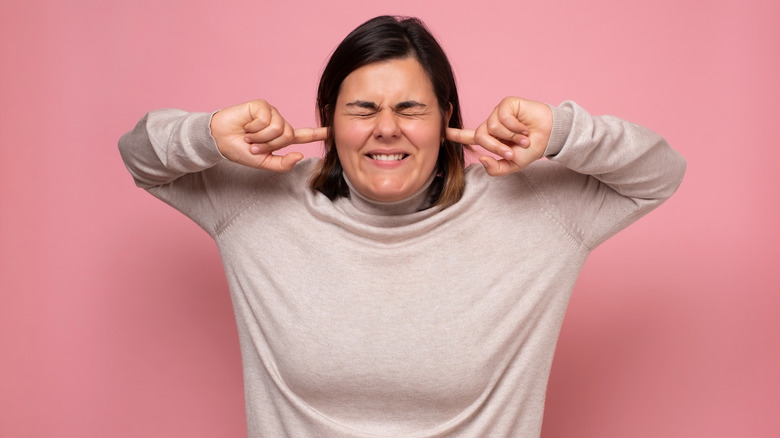
Koldunov/Shutterstock
There’s nothing like the sound of incessant throat clearing, videos playing from a device with improperly plugged earphones, and non-stop conversation in the next row to keep you from your slumber.
No earplug can truly block every noise from reaching your ears, but the really good ones can still stifle too much to be truly safe to wear while you fly. For the utmost safety on an airplane, you need to be able to hear and respond to announcements and instructions. Ok, fair, you might not feel the burning need to hear how much the airline values their frequent fliers or the weather at your destination, but if you are heading into turbulence or facing an emergency, you’ll need to know that.
The same goes for noise-canceling headphones that are plugged into anything other than the plane’s inflight entertainment system (IFE). The IFE, whether it is a seatback screen or an app downloaded to your device, is designed to pause your music or movie during announcements. If you need to create a quiet oasis for yourself, make sure you can hear what you need for your safety and stick to the entertainment distractions provided by the airline.
Ultra casual clothes at all costs
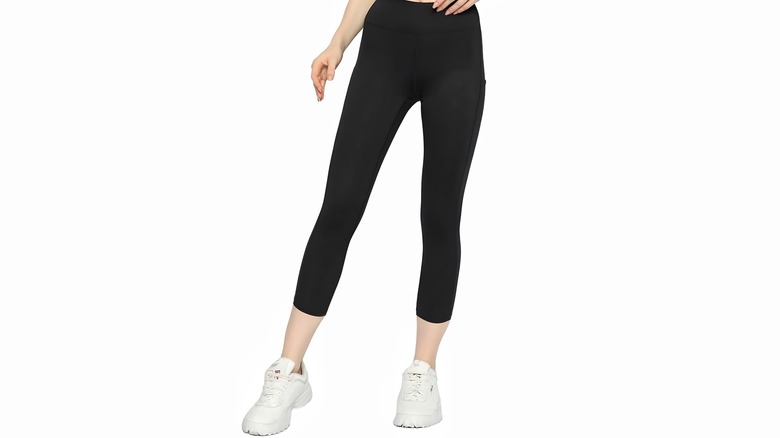
Refox Photos/Shutterstock
While visions of fashion-plate jetsetters are a beautiful picture, the reality of air travel is decidedly more casual. Most of us like to err on the side of comfort, all the more so if we plan to sleep. While we would never bash a good pair of leggings or athleisure wear fit, they might not be the best choice for travel wear.
An unfortunate and often (probably for the best) unacknowledged aspect of flying through the heavens in a pressurized vessel is bloating and gas. Scientific American attributes it to “Changes in cabin pressure and oxygen saturation, along with the vibration and motion of the plane, [which] can inhibit gastric emptying.” That bloating means any clothing that feels tight and constricting is going to be all the more so in the air. That’s not comfortable, and if it’s not comfy, it’s not going to ease your way to dreamland any time soon.
Additionally, as terrible as an emergency is to contemplate, lots of yoga pants and the like are crafted from artificial materials. Flammable, artificial materials. Aircraft fires are rare, but in the event you have to face one, you are better off in natural materials like cotton, wool, or bamboo. As an added, entirely non-emergency-related bonus, natural materials tend to be breathable and not hold on to odor, which we obviously love.
Douse yourself in aromatherapy scents
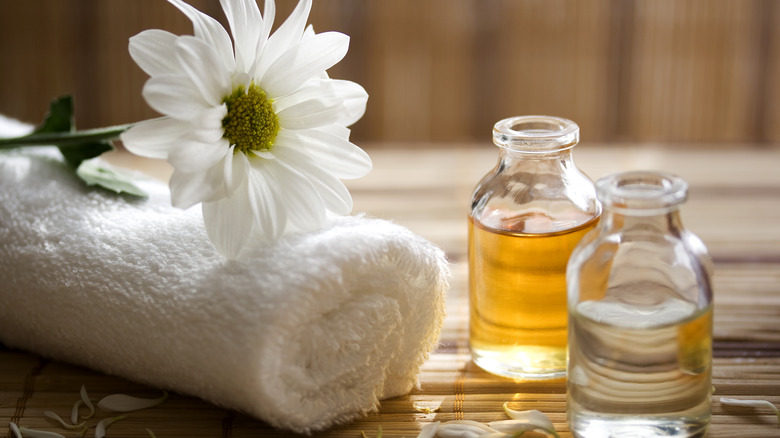
Damircudic/Getty Images
Lavender and chamomile, clary sage, rose, and frankincense are all relaxing smells said to promote peaceful sleep and relaxation. At home, a few spritzes on your pillow and bed linens, rolled over your pulse points, or added to your scent diffuser can be a gentle way to ease the way into the land of Nod.
The same effects remain when you are in the air, but confine yourself to a quick sniff rather than bathing yourself in therapeutic smells. Try gently wafting the scent under your nose to enjoy the benefits. The scent may be something you love, but your seatmates may not feel the same. Be mindful of passengers with allergies and scent sensitivities. It can be miserable, even unhealthy for some people, and they don’t have anywhere to escape. Your sleep is important, but it isn’t more important than someone else’s health. Besides, you aren’t going to sleep very well with a sneezing, sniffling person beside you.
Bundle up under a big blankie
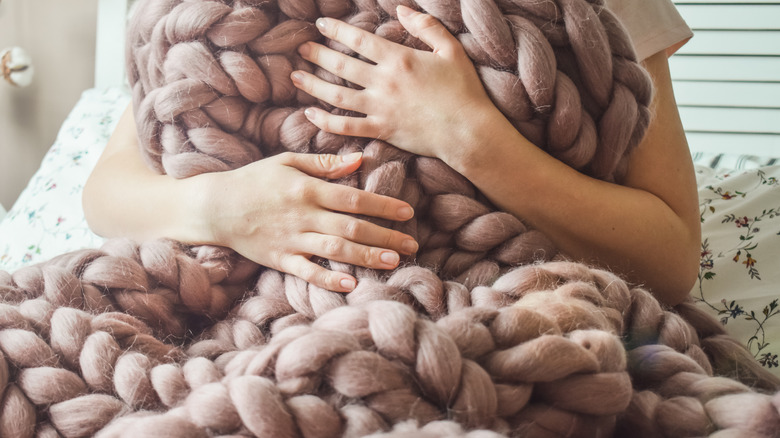
S_Zozulya/Shutterstock
An oversized pashmina shawl or a cozy travel blanket can be just the ticket to a comfy sleep. Airplane cabins can be chilly, and having the extra layer of warmth really helps. Just make sure you buckle your seatbelt over the blanket, not underneath it. It may feel strange or counterintuitive, but there’s a good reason — trust us!
That reason is to keep your sleep peacefully uninterrupted. Flight attendants have to check periodically that people are buckled in, particularly at take-off and landing. Any time the captain anticipates rough air, the seatbelt light goes on. The flight crew isn’t just being pedantic. They are reminding you of federal regulation 14 CFR 121.317(f), which states: “Each passenger required by §121.311(b) to occupy a seat or berth shall fasten his or her safety belt about him or her and keep it fastened while the “Fasten Seat Belt” sign is lighted.” People really do get hurt from being tossed around by turbulence, and it can happen fast. If you have the seatbelt hidden under a blanket, flight attendants are obligated to wake you up to check your seat belt. So avoid having your slumbers disturbed by buckling up … and over.
Let your feet breathe
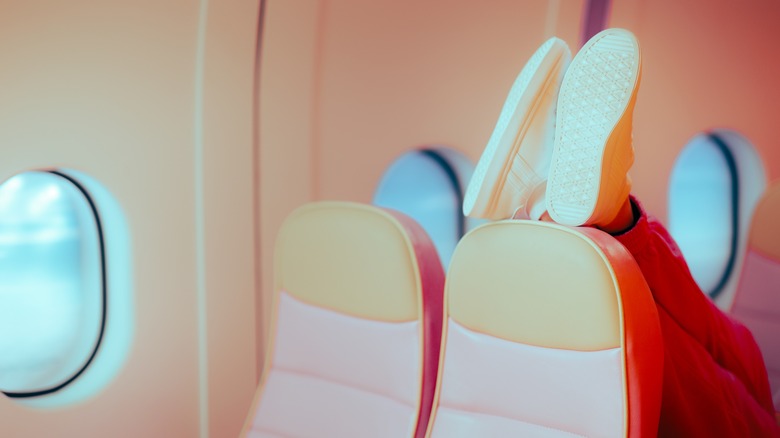
Nicoleta Ionescu/Shutterstock
Sleeping in shoes is not comfortable; few people will argue that. However, taking your shoes off when you fly, even in the name of good sleep, might not be worth it. Planes are not notoriously clean places, and having your feet out is the opposite of hygienic. Plus, to all but a niche group of enthusiasts, feet are better when they are not on display. You may find it simply impossible to sleep with your shoes on and must remove them for a peaceful snooze, but you really should keep your socks on. Not only is it a layer of protection for you, it will keep you from inadvertently spreading any nastiness. And put your shoes back on when you go to the bathroom. Accidents happen, and trust us, you don’t want to step in it.
On a more serious note, keeping your shoes on during take-off and landing is a safety issue. Statistically speaking, take-off and landing are the most dangerous parts of the flight, and emergencies are most likely to occur at these points. Ensure your shoes are on. It is extremely unlikely, but if an emergency happens, you want to evacuate with your feet protected.
Cough syrup and allergy meds can help you sleep

New Africa/Shutterstock
Many over-the-counter medicines, such as allergy meds, cough syrup, and motion sickness tablets, have drowsiness as a side effect. It may be tempting to dose yourself a bit in the name of helping your sleepiness along. However, this is never a good idea. Using a medicine for something other than its intended use is called “off-label use,” and it can be dangerous, especially when you are the one playing doctor. Dr. Philip Alapat, in the Baylor College of Medicine newsletter, cautions against the use of antihistamines as a sleep aid. The news story states, “While antihistamines may help you to fall asleep, overall sleep quality is usually not very good … Sometimes, they even have the opposite effect and cause hyperactivity, especially in children.” It goes on to note that people may experience side effects like altered mental state, urinary retention, and dry mouth.
In addition, when you are flying, you need to be alert and able to comply with instructions in an emergency. A small amount of medicine usually won’t knock you out completely, but a danger of self-prescribed off-label medicine is that there is no set dosage for how you are using the medication; you don’t want to risk it and take more than is wise.
Fly First Class
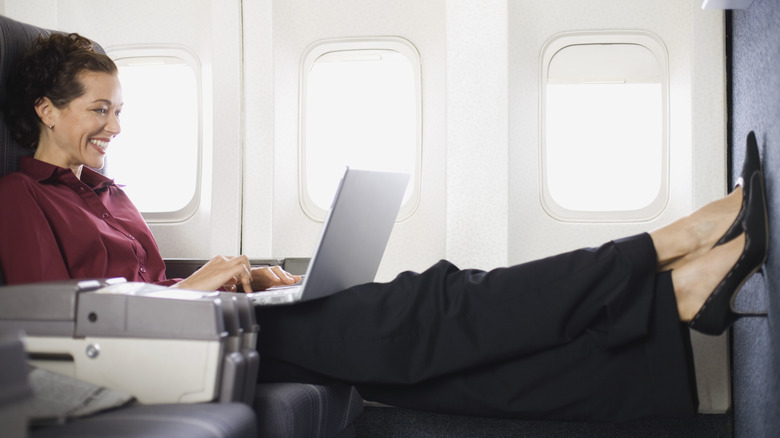
Jupiterimages/Getty Images
Of all the ideas for getting better sleep on a plane you may come across, the suggestion to buy a seat with more room is probably one of the best. There’s no danger here, but the drawback, of course, is that it is expensive. A business class seat is generally three or four times more costly than a seat in economy. Look hard at your trip budget to decide if it’s worth it. In many cases, the extra money you spend on your upgraded seat could be spent on a few more nights at a hotel or a VIP tour of an attraction at your destination.
If a seat in first or business class isn’t in the cards, there are other ways to get a bit more room. Look for “Premium economy” seats when you book your tickets or select a seat at the front of the section (bulkhead) or a seat in an emergency row. You will need to pay for the extra room, but it won’t be as much as you would pay for a seat in a higher class.
If you do opt for a seat in first, you may be able to save a bit by booking an economy seat and then bidding for an upgrade online (if the airline has this option) or asking at check-in to upgrade your seat. Some travelers have found the prices are lower this way than they are booking a business seat from the outstart.
Stick your head in a goofy contraption
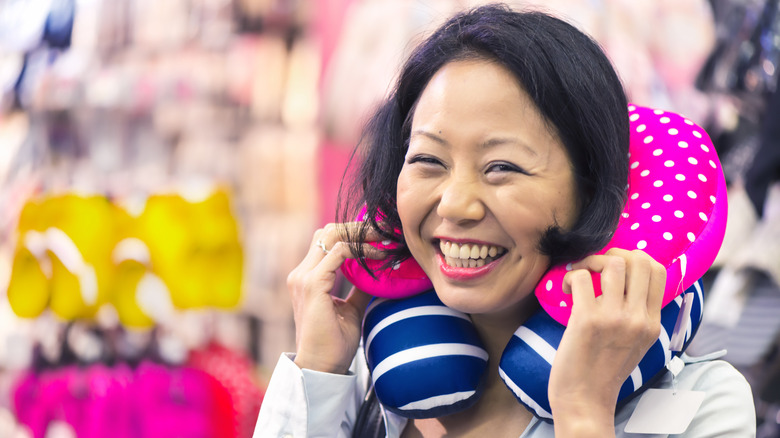
Helovi/Getty Images
Travel pillows are only the tip of the iceberg regarding travel sleep products. Inflatable pods, complicated sleep stations for your head and arms — it can get overwhelming. While some of the designs are admittedly intriguing, some are so strange that they make you wonder if they are actually an elaborate joke.
One such creation is the Ostrich Pillow, made famous by Catharine O’Hara’s character of Moira in “Schitt’s Creek.” Despite looking undeniably wacky, the pillow does receive overwhelmingly positive reviews online. Another interesting invention is the Skyrest. This inflatable pillow has cutouts where you can tuck your arms in to try and get into as comfortable a position as possible. However, the fully inflated dimensions may be a bit unwieldy in the tight quarters of your seat.
Some others seem to be trading on the public’s desperation to get some sleep on an airplane and can feel like they are not actually very helpful. A good eye mask and a compact pillow are unobtrusive and easy.
Lay that seat all the way back
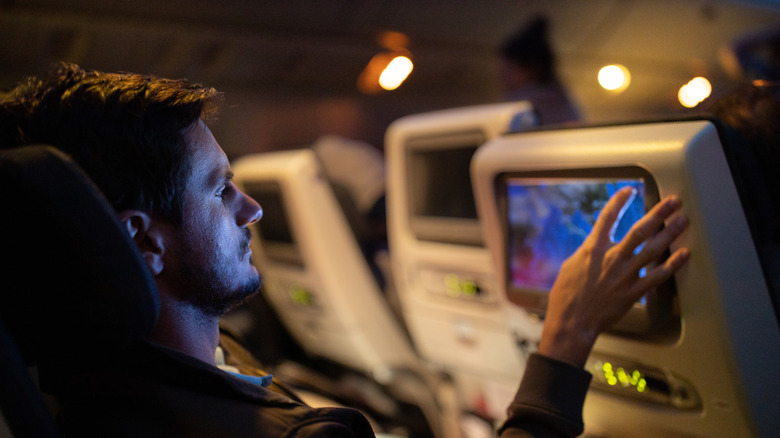
Skynesher/Getty Images
You get such little space in an airplane seat, and the incline is uncomfortable. Who could blame you for wanting more room while you try to sleep? Of all the airline etiquette debates, to recline or not to recline has to rank right up there with who gets the shared armrest. (For the record, it’s the person in the middle). The thing about reclining your seat is that it encroaches on the space of the person behind you. On planes that still have screens in the back of the headrest, that means you are forcing them to get an up-close view of their movie, whether they want it or not. Their legs will be pressed against the back of the seat, so you may get jostled when they cross their legs. Laptops have been broken by careless people pushing their seats back without looking.
If your body requires you to recline, look before you lean. If the person behind you has long legs or a big body, is holding a baby, or is working on a laptop, don’t do it. Talk to an attendant to see if there is a seat you can move to. If it looks all clear, lean back slowly, sit up during meals and drinks service, and understand if you get bumped. The person behind you doesn’t have much room either.
Pop a pill
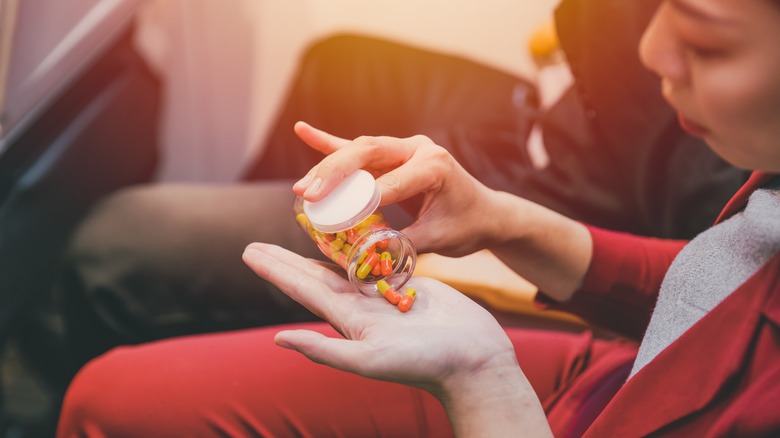
Quality Stock Arts/Shutterstock
If you have insomnia or other sleep issues, a prescription for a sleep aid is a wonderful thing. It may seem natural to medicate yourself as usual on an overnight flight. We don’t want to be the sleep police, but not so fast!
You should talk to your doctor or pharmacist before you take medication when traveling. Yes, even medicine you’ve been prescribed. The effect of medication may be different at a high altitude, and facing an unusual reaction when you are in the air is far from ideal. As Dr. Jason Singh, founder of One Oak Medical, told Explore, “Sleeping pills, especially those in a class of sedative-hypnotics like benzodiazepines or non-benzodiazepine receptor agonists (i.e. Zolpidem/Ambien) can have adverse effects, especially at high altitudes.”
He adds that medically assisted rest may not be as refreshing as travelers would wish and can leave them feeling groggy on arrival, with exacerbated symptoms of jetlag. Relying on sleeping pills long-term can lead to problems like cognitive and memory impairments and falls.

